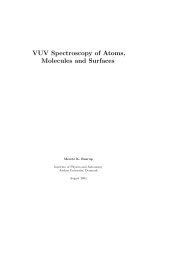Paramount GT-1100 Robotic Telescope Mount
Paramount GT-1100 Robotic Telescope Mount
Paramount GT-1100 Robotic Telescope Mount
You also want an ePaper? Increase the reach of your titles
YUMPU automatically turns print PDFs into web optimized ePapers that Google loves.
page 28 <strong>Paramount</strong> User’s Guide<br />
Note: The <strong>Paramount</strong> ME, as pictured in Figure 15, is in an unstable configuration and<br />
places extreme forces on the right ascension gear teeth. The counterweight shaft should<br />
remain in the vertical position while the <strong>Paramount</strong> ME is loaded with counterweights and<br />
the OTA has not yet been attached. This minimizes the force on the right ascension gear<br />
teeth and insures the mount is in a stable position at all times.<br />
Balance the system<br />
Attach your CCD camera and all other equipment (focuser, dew heater, etc.) to the optical<br />
tube assembly while balancing the mount. The telescope will track and slew best when<br />
properly balanced. An unbalanced system can cause numerous problems, such as stalling or<br />
“gear chattering” during slews. There is no clutching mechanism on the <strong>Paramount</strong> ME.<br />
This means that balance is achieved by disengaging the worm from the gear in each axis.<br />
Caution!<br />
Use extreme care when balancing the telescope! Make note of the weight<br />
distribution on the telescope before pulling the worm block assemblies away from<br />
the gears. Always grab hold of the OTA or counterweight arm before disengaging the<br />
worm and gear so that you maintain control of the telescope.<br />
The telescope could be damaged, or you could be seriously injured whenever the worm gear<br />
is disengaged from the main gear on an unbalanced system.<br />
The <strong>Paramount</strong> ME comes with two 9 kg (20 lb.) counterweights to balance the optical tube<br />
assembly. To balance the right ascension axis, slide the counterweights up or down the<br />
counterweight bar until the system has no tendency to fall in either direction.<br />
If you use multiple devices, such as a video camera to map and a CCD to image after<br />
mapping, the difference in weight might be enough to cause slewing problems when the<br />
instruments are interchanged. By marking various positions of counterweights on the shaft<br />
for different configurations, you can quickly rebalance a system without disengaging the<br />
worm and gear. It is very important not to change the system after mapping has been<br />
completed and a model is created for the mount/OTA.<br />
The worm blocks on the ME provide a mechanism for disengaging the worm from the gear<br />
and holding this configuration while balancing. Though it is always a good idea to have a<br />
second person available for aid in holding the OTA during balancing, this mechanism allows<br />
for single person balancing.















